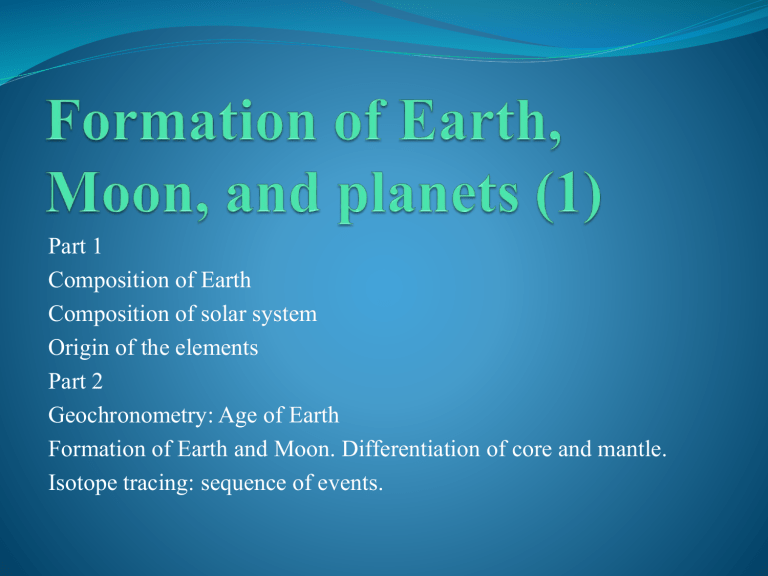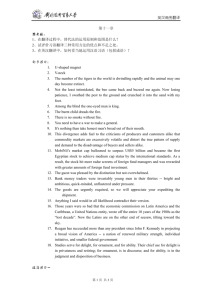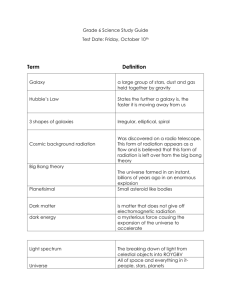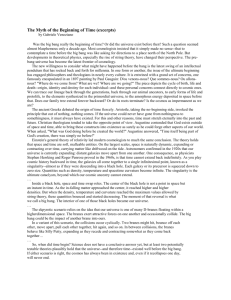pptx

Part 1
Composition of Earth
Composition of solar system
Origin of the elements
Part 2
Geochronometry: Age of Earth
Formation of Earth and Moon. Differentiation of core and mantle.
Isotope tracing: sequence of events.
Internal structure known from seismology. Radial distribution of seismic wave velocity and density. Spherically symmetric reference model (PREM)
Composition of Earth?
Crust and mantle: mostly silicates
Core: Fe Ni
Distribution of elements in Earth
Abundance of elements in solar system is quite similar
(except for H, He)
Abundance measured in Sun’s photosphere and in meteorites.
Where do the elements come from?
How did Universe evolve? Expanding universe
Olbers paradox: Why is the sky dark at night?
Hubble’s expanding universe
Gamow’s Big bang: only H and He were formed in Big bang
Penzias & Wilson: Cosmic background radiation
Short history of the Universe
Olbers paradox: why is the sky dark at night?
Assume universe is ∞ and density of stars and galaxies is uniform
Energy received from distant star ~ r -2
Number of stars between r and r +dr ~ 4 π r 2 dr
Energy received from universe of radius r ~ r
If universe is ∞, energy received is ∞
Hubble’s expanding universe
Universe finite or infinite?
Is Universe in steady state?
Einstein’s general relativity framework for cosmology. Steady state solutions.
Friedmann-Lemaitre dynamic universe.
Hubble discovers that spectrum of distant stars is shifted toward the red, i.e. toward lower frequencies.
Doppler shift frequency ω obs
= ω source
/(1+v/c) (v velocity away from source)
Interpretation: Doppler shift. Stars are moving away. The further they are, the faster they are moving away!
Age and radius of the Universe
Hubble constant = v / r (velocity / distance)
Assuming v constant, star at distance r has traveled away from us at velocity v for time r/v = 1/H
If H = 50 (km/s)/Mparsec
(1 parsec = 3 LY = 3 x 3 10
Age = 1/H ~ 20 Gyr
Velocity of light c = limit
Radius of Universe when c is reached
R = H c
7 x 3 10 5 km = 3 10
(Overestimated if expansion slows down)
13 km)
Hubble constant and age of the Universe
Note: It was very difficult to determine distance. In 1920, the
Hubble constant was over-estimated and the age of the
Universe was thought to be 2 Gyr (i.e. < age of Earth). Present estimate is 13.5Gyr
Alpher, Bethe, Gamow: α-β-γ
Gamow suggested that synthesis of elements from elementary particles occurred following the Big Bang.
Using nuclear physics, Gamow et al. predicted that only H and He could have been synthesized and that the Universe is made of 76 % H and 24 %
He
This is roughly what is observed.
Question: Where do the other elements come from? They are synthesized by nuclear reactions in stars.
(Bethe cycle).
Other consequence: when electromagnetic radiation and matter decouple: atoms become stable. Cosmic background radiation (radiation from decoupling time) must fill the Universe.
4 Fundamental forces in physics.
Gravity
Weak (holds neutron together) Note that free neutron is not stable n -> p + e + ν
e
Electromagnetic (holds atoms together)
Strong (holds nuclei)
When temperature and energy density in Universe decrease, nuclei become stable. Then as Universe gets colder atoms become stable and electromagnetic radiation does not interact with matter any more. Remnant electromagnetic radiation from time of decoupling is cosmic background radiation
Elements abundance
The term nucleosynthesis refers to the formation of heavier elements, atomic nuclei with many protons and neutrons, from the fusion of lighter elements. The Big
Bang theory predicts that the early universe was a very hot place. One second after the Big Bang, the temperature of the universe was roughly 10 billion degrees and was filled with a sea of neutrons, protons, electrons, antielectrons (positrons), photons and neutrinos. As the universe cooled, the neutrons either decayed into protons and electrons or combined with protons to make deuterium (an isotope of hydrogen). During the first three minutes of the universe, most of the deuterium combined to make helium. Trace amounts of lithium were also produced at this time. This process of light element formation in the early universe is called “Big Bang nucleosynthesis” (BBN).
The predicted abundance of deuterium, helium and lithium depends on the density of ordinary matter in the early universe, as shown in the figure at left. These results indicate that the yield of helium is relatively insensitive to the abundance of ordinary matter, above a certain threshold. We generically expect about 24% of the ordinary matter in the universe to be helium produced in the Big Bang. This is in very good agreement with observations and is another major triumph for the Big
Bang theory.
Blackbody radiation
Stefan’s law
Total Power radiated ~ σ T 4
(5.6 10 -8 W m -2 K -4 )
Distribution of energy / frequency
(wavelength) of radiation depends on temperature. By determining power spectrum of radiation, we can determine temperature.
Radiation and the expansion of the Universe
Electromagnetic radiation in expanding universe.
Energy inversely proportional to wavelength (E=hν=hc/λ)
Wavelength of radiation increases in expanding universe.
Energy density decreases (Total energy conserved)
Temperature decreases: Present temperature ~3K
Summary CMB radiation
The existence of the CMB radiation was first predicted by
George Gamow in 1948, and by Ralph Alpher and Robert
Herman in 1950. It was first observed inadvertently in
1965 by Arno Penzias and Robert Wilson at the Bell
Telephone Laboratories in Murray Hill, New Jersey. The radiation was acting as a source of excess noise in a radio receiver they were building. Coincidentally, researchers at nearby Princeton University, led by Robert Dicke and including Dave Wilkinson of the WMAP science team, were devising an experiment to find the CMB. When they heard about the Bell Labs result they immediately realized that the CMB had been found. The result was a pair of papers in the Physical Review: one by Penzias and Wilson detailing the observations, and one by Dicke, Peebles,
Roll, and Wilkinson giving the cosmological interpretation. Penzias and Wilson shared the 1978 Nobel prize in physics for their discovery.
Today, the CMB radiation is very cold, only 2.725° above absolute zero , thus this radiation shines primarily in the microwave portion of the electromagnetic spectrum , and is invisible to the naked eye. However, it fills the universe and can be detected everywhere we look. In fact, if we could see microwaves, the entire sky would glow with a brightness that was astonishingly uniform in every direction. The temperature is uniform to better than one part in a thousand! This uniformity is one compelling reason to interpret the radiation as remnant heat from the
Big Bang; it would be very difficult to imagine a local source of radiation that was this uniform.
Evolution of early universe (first 3 minutes)
Universe expands: it gets less dense and colder
Particles become stable (p+ p- <->γ) (e+ e-<->γ) (p++ e- <->n + ν)
Free neutrons are unstable
Nuclei form: neutrons fixed and stable in nuclei
At 3000K, atoms become stable. No more interaction between electromagnetic radiation and matter (atoms)
Radiation cools down in expanding universe
Element abundance in solar system
Note peak of Fe
Star formation and evolution
Gravitational collapse yields energy (~3GM 2 /5R)
When pressure and temperature increase in the collapsing star, there is enough energy to start nuclear fusion reactions which yield more energy
Balance between pressure and gravity maintains the interior of the star in
(non-equilibrium) steady-state.
At the end of the life of star, fuel is burned, star collapses, with several possible scenarios depending on mass of star: it will collapse and end as white dwarf, neutron star, black hole, or explode as nova or super nova)
Nova explosion allows elements heavier than Fe to be removed from reactions and preserved.
Origin of elements: Stardust.
Elements other than H and He do not come from Big Bang. (Sun is a second generation star!)
Nucleosynthesis in stars. (reactions H + H -> D (H
D+H > He 3 He 3 + He
Note the peak of Fe
3 -> He 4
2 )
+ H + H … etc. liberate energy)
It corresponds to minimum energy /nucleon
Synthesizing elements heavier than Fe requires that energy is provided
Available in stars, but if heavy elements are not removed, they will react to return to minimum energy
2 ways to remove heavy elements. Reaction in star atmosphere and expulsion in space.
Explosion of the star (Nova, Super nova)
Hypotheses Solar system formation
Constraints
Sun = 99% of mass
Planets = 99 % of angular momentum
Bode’s law
Distribution of Elements
Recent cosmochemical data
(isotopes, etc.)
Planets extracted from sun by passing star (Jeans-Jeffreys)
Sun formed then captured planets from cloud
Sun and planets formed together
(Laplace)
Clues to the Formation of the Solar System
Inner planets are small and dense
Outer planets are large and have low density
Satellites of the outer planets are made mostly of ices
Cratered surfaces are everywhere in the Solar System
Saturn has such a low density that it can't be solid anywhere
Formation of the Earth by accretion: Initial solar nebula consists of mixtures of grains (rock) and ices. The initial ratio is about 90% ices and 10% grains
The sun is on so there is a temperature gradient in this mixture
:
Take home message?
Anisotropy in CMB very weak
The data brings into high resolution the seeds that generated the cosmic structure we see today. These patterns are tiny temperature differences within an extraordinarily evenly dispersed microwave light bathing the Universe, which now averages a frigid 2.73
degrees above absolute zero temperature. WMAP resolves slight temperature fluctuations, which vary by only millionths of a degree.
The Origin of the Cosmic Microwave Background
One of the basic predictions of the Big Bang theory is that the universe is expanding . This expansion indicates the universe was smaller, denser and hotter in the distant past.
When the visible universe was half its present size, the density of matter was eight times higher and the cosmic microwave background was twice as hot. When the visible universe was one hundredth of its present size, the cosmic microwave background was a hundred times hotter (273 degrees above absolute zero, the temperature at which water freezes to form ice on the Earth's surface). In addition to this cosmic microwave background radiation, the early universe was filled with hot hydrogen gas with a density of about 1000 atoms per cubic centimeter. When the visible universe was only one hundred millionth its present size, its temperature was 273 million degrees above absolute zero and the density of matter was comparable to the density of air at the Earth's surface. At these high temperatures, the hydrogen was completely ionized into free protons and electrons.
Since the universe was so very hot through most of its early history, there were no atoms in the early universe, only free electrons and nuclei. (Nuclei are made of neutrons and protons). The cosmic microwave background photons easily scatter off of electrons.
Thus, photons wandered through the early universe, just as optical light wanders through a dense fog. This process of multiple scattering produces what is called a “thermal” or
“blackbody” spectrum of photons. According to the Big Bang theory, the frequency spectrum of the CMB should have this blackbody form. This was indeed measured with tremendous accuracy by the FIRAS experiment on NASA's COBE satellite.
Nucleosynthesis
The term nucleosynthesis refers to the formation of heavier elements, atomic nuclei with many protons and neutrons, from the fusion of lighter elements. The Big Bang theory predicts that the early universe was a very hot place. One second after the Big
Bang, the temperature of the universe was roughly 10 billion degrees and was filled with a sea of neutrons, protons, electrons, anti-electrons (positrons), photons and neutrinos. As the universe cooled, the neutrons either decayed into protons and electrons or combined with protons to make deuterium (an isotope of hydrogen). During the first three minutes of the universe, most of the deuterium combined to make helium. Trace amounts of lithium were also produced at this time. This process of light element formation in the early universe is called “Big Bang nucleosynthesis” (BBN).
The quantity of light elements predicted for a given universe density serves as a double check on density observationsThe predicted abundance of deuterium, helium and lithium depends on the density of ordinary matter in the early universe, as shown in the figure at left. These results indicate that the yield of helium is relatively insensitive to the abundance of ordinary matter, above a certain threshold. We generically expect about 24% of the ordinary matter in the universe to be helium produced in the Big Bang. This is in very good agreement with observations and is another major triumph for the Big Bang theory.
However, the Big Bang model can be tested further. In order for the predicted yields of the other light elements to come out in agreement with observations, the overall density of the ordinary matter must be roughly 4% of the critical density. The WMAP satellite should be able to directly measure the ordinary matter density and compare the observed value to the predictions of
Big Bang nucleosynthesis. This will be an important and stringent test of the model. If the results agree, it will be a further evidence in support of the Big Bang theory. If the results are in conflict, it will either point to 1) errors in the data, 2) an incomplete understanding of the process of Big Bang nucleosynthesis, 3) a misunderstanding of the mechanisms that produce fluctuations in the microwave background radiation, or 4) a more fundamental problem with the Big Bang theory.
Nucleosynthesis in Stars
Elements heavier than lithium are all synthesized in stars. During the late stages of stellar evolution, massive stars burn helium to carbon, oxygen, silicon, sulfur, and iron. Elements heavier than iron are produced in two ways: in the outer envelopes of super-giant stars and in the explosion of a supernovae. All carbon-based life on Earth is literally composed of stardust.
Additional information for reading
The Big Bang theory predicts that the early universe was a very hot place and that as it expands, the gas within it cools. Thus the universe should be filled with radiation that is literally the remnant heat left over from the Big Bang, called the “cosmic microwave background radiation”, or CMB.
Noble winners Penzias and Wilson with the 1965 CMB detector.The existence of the CMB radiation was first predicted by George Gamow in 1948, and by Ralph Alpher and
Robert Herman in 1950. It was first observed inadvertently in 1965 by Arno Penzias and Robert Wilson at the Bell Telephone Laboratories in Murray Hill, New Jersey. The radiation was acting as a source of excess noise in a radio receiver they were building. Coincidentally, researchers at nearby Princeton University, led by Robert Dicke and including Dave Wilkinson of the WMAP science team, were devising an experiment to find the CMB. When they heard about the Bell Labs result they immediately realized that the CMB had been found. The result was a pair of papers in the Physical Review: one by Penzias and Wilson detailing the observations, and one by Dicke, Peebles, Roll, and
Wilkinson giving the cosmological interpretation. Penzias and Wilson shared the 1978 Nobel prize in physics for their discovery.
Uniform color oval representing the temperature variation across the sky of the CMB.Today, the CMB radiation is very cold, only 2.725° above absolute zero, thus this radiation shines primarily in the microwave portion of the electromagnetic spectrum, and is invisible to the naked eye. However, it fills the universe and can be detected everywhere we look. In fact, if we could see microwaves, the entire sky would glow with a brightness that was astonishingly uniform in every direction. The picture at left shows a false color depiction of the temperature (brightness) of the CMB over the full sky (projected onto an oval, similar to a map of the Earth). The temperature is uniform to better than one part in a thousand! This uniformity is one compelling reason to interpret the radiation as remnant heat from the Big Bang; it would be very difficult to imagine a local source of radiation that was this uniform. In fact, many scientists have tried to devise alternative explanations for the source of this radiation but none have succeeded.
Since light travels at a finite speed, astronomers observing distant objects are looking into the past. Most of the stars that are visible to the naked eye in the night sky are 10 to
100 light years away. Thus, we see them as they were 10 to 100 years ago. We observe Andromeda, the nearest big galaxy, as it was three million years ago. Astronomers observing distant galaxies with the Hubble Space Telescope can see them as they were only a few billion years after the Big Bang. (Most cosmologists believe that the universe is between 12 and 14 billion years old.)
One of the basic predictions of the Big Bang theory is that the universe is expanding. This expansion indicates the universe was smaller, denser and hotter in the distant past.
When the visible universe was half its present size, the density of matter was eight times higher and the cosmic microwave background was twice as hot. When the visible universe was one hundredth of its present size, the cosmic microwave background was a hundred times hotter (273 degrees above absolute zero or 32 degrees Fahrenheit, the temperature at which water freezes to form ice on the Earth's surface). In addition to this cosmic microwave background radiation, the early universe was filled with hot hydrogen gas with a density of about 1000 atoms per cubic centimeter. When the visible universe was only one hundred millionth its present size, its temperature was 273 million degrees above absolute zero and the density of matter was comparable to the density of air at the Earth's surface. At these high temperatures, the hydrogen was completely ionized into free protons and electrons.
Since the universe was so very hot through most of its early history, there were no atoms in the early universe, only free electrons and nuclei. (Nuclei are made of neutrons and protons). The cosmic microwave background photons easily scatter off of electrons. Thus, photons wandered through the early universe, just as optical light wanders through a dense fog. This process of multiple scattering produces what is called a “thermal” or “blackbody” spectrum of photons. According to the Big Bang theory, the frequency spectrum of the CMB should have this blackbody form. This was indeed measured with tremendous accuracy by the FIRAS experiment on NASA's COBE satellite.
FIRAS SpectrumThis figure shows the prediction of the Big Bang theory for the energy spectrum of the cosmic microwave background radiation compared to the observed energy spectrum. The FIRAS experiment measured the spectrum at 34 equally spaced points along the blackbody curve. The error bars on the data points are so small that they can not be seen under the predicted curve in the figure! There is no alternative theory yet proposed that predicts this energy spectrum. The accurate measurement of its shape was another important test of the Big Bang theory.
“Surface of Last Scattering”
Eventually, the universe cooled sufficiently that protons and electrons could combine to form neutral hydrogen. This was thought to occur roughly 400,000 years after the Big
Bang when the universe was about one eleven hundredth its present size. Cosmic microwave background photons interact very weakly with neutral hydrogen.
CMB Surface of Last Scattering compared to looking up at a cloud surface.The behavior of CMB photons moving through the early universe is analogous to the propagation of optical light through the Earth's atmosphere. Water droplets in a cloud are very effective at scattering light, while optical light moves freely through clear air. Thus, on a cloudy day, we can look through the air out towards the clouds, but can not see through the opaque clouds. Cosmologists studying the cosmic microwave background radiation can look through much of the universe back to when it was opaque: a view back to 400,000 years after the Big Bang. This “wall of light“ is called the surface of last scattering since it was the last time most of the CMB photons directly scattered off of matter. When we make maps of the temperature of the CMB, we are mapping this surface of last scattering.
As shown above, one of the most striking features about the cosmic microwave background is its uniformity. Only with very sensitive instruments, such as COBE and WMAP, can cosmologists detect fluctuations in the cosmic microwave background temperature. By studying these fluctuations, cosmologists can learn about the origin of galaxies and large scale structures of galaxies and they can measure the basic parameters of the Big Bang theory.
Steps in the accretion process
Step 1: accretion of cm sized particles
Step 2: Physical Collision on km scale
Step 3: Gravitational accretion on 10-100 km scale
Step 4: Molten protoplanet from the heat of accretion
Final step is differentiation of the earth: Light objects float; heavy objects sink.
Iron-Nickel Core (magnetic field) and oxygen-silicon crust
In the outer part of the solar system, the same 4 step process of accretion occurred but it was accretion of ices (cometisemals) instead of grains.
Planetary accretion: energy aspects(1).
When planet starts to form. Nucleus collides with other bodies
(planetisimals).
Collisions give energy. Kinetic energy is converted into heat.
How much energy is available.
Assume that accretion brings together particles from infinite distance.
Gravitational potential energy converted to kinetic energy which is converted to heat.
Energy avalailable: self potential energy of a sphere
E = 3 G M
Energy / unit mass = 3 G M / 5 R (This is a big number!!!)
(G gravitational ~ 6.6 10 -11 N m 2 /kg 2 (m 3 /s 2 /kg) , R radius, M mass of
Earth)
2 / 5R
Planetary accretion: energy aspects (2).
When planet becomes hot, it radiates energy.
Black body radiation
Total energy radiated = (4 π R 2 σ T 4 )
But impacts cause dense cloud of dust
How much energy can be radiated depends on how long it takes for the planet to accrete.
What happens when core forms?
Things to note about the formation of planets via accretion
There is a lot of heat dissipated in the final accretion process resulting in initially molten objects
Any molten object of size greater than about 500 km has sufficient gravity to cause gravitational separation of light and heavy elements thus producing a differentiated body
The accretion process is inefficient, there is lots of left over debris.
In the inner part of the solar system, the leftover rocky debris cratered the surfaces of the newly formed planets.
In the outer part of the solar system, much of the leftover rocky debris was ejected from the solar system due to the large masses of the planets which formed there. Some of this material was ejected into a large "Comet Cloud" which has a distance of about 100,000 AU from the Sun and some of the leftover debris ( beyond Pluto) could not be ejected (as it was far away from
Uranus and Neptune) and hence remained there. This material is known as the Kuiper Belt and it was recently discovered by the Hubble Space
Telescope
Bode Law
Planet # k
Orbit radius = k p p ~ 2/3





